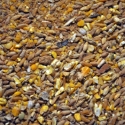What’s in Poultry Feed – Part I

One of the most common questions I am asked in my job time after time is “Can you tell me what is in your feed?” People are naturally curious about the ingredients in their animal’s feed and have been trained to read labels on the food we eat, so why not on the feed our animals eat? Most poultry feeds consist of similar main ingredients, the most common of which are discussed below:
Soybean Meal This is the most common form of plant protein, and if your feed tag lists “plant protein products” as an ingredient, chances are soybean meal is what is being used. Soybeans are readily available throughout the country and have the highest concentration of protein of any of our plant sources, with a typical level of 44-48%. When high protein soybean meal is blended with other ingredients, it can raise the overall protein content of the feed. Additionally, soybean meal contains a close match nutritionally to what animals require for amino acids. Especially important in this profile is the amino acid lysine, which is essential in young growing animals.
Canola Meal is sometimes used in conjunction with or as a replacement for soybean meal. While the protein content is not quite as high, this ingredient is still considered a great source of plant-based protein.
Corn is added to feed as an energy source and provides a whopping 1.54 Mcal of digestible energy (DE) per pound (1.54 Mcal/lb = 1540 Kcal/lb = 1540 Calories/lb). If “grain products” are listed on your tag, it is usually referring to corn, wheat, or other grains. Feeding grain as an ingredient in a complete feed helps to provide the energy necessary for maximum egg production and optimum growth. However, feeding straight corn or other grains (like those found in scratch) in excess by themselves can be detrimental to the health of your birds. With low protein content and no vitamins or minerals added, too much grain alone can affect laying rate, growth rate, and overall health and immunity. Keep any added straight grain at no more than 15% of the total diet, with the bulk of the ration being a commercial poultry feed.
Wheat Midds are obtained from the milling of wheat, wheat bran, wheat shorts, wheat germ and wheat flour. Wheat midds may be represented on your feed tag as “processed grain by-products”. To many people, by-products have a negative connotation. Most think of by-products as “left overs” or “fillers”. This is simply not true. Some of the most nutrient rich ingredients we have for poultry feeds are made of the product that remains after a grain has been processed for another specific purpose. Midds in particular are a good source of energy, protein and fiber. Additionally, wheat midds help create a nice pellet that holds together well; midds can enhance the quality and make a clean pellet with minimal dust and fines.
These main ingredients typically make up the highest inclusion of most poultry feeds. In the next article in our series, we will explore the differences in nutrition that can be made by value-added ingredients, such as probiotics and prebiotics, marigold extract, and others!
